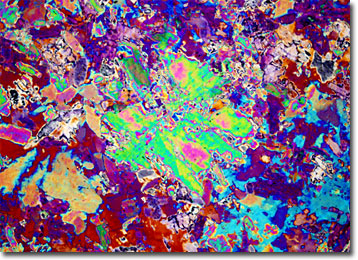Polarized Light Microscopy Digital Image Gallery
Lepidolite
Lepidolite is a type of mica that derives its name from the Greek words lepidon, meaning “scale,” and lithos, meaning “stone.” The aluminum silicate mineral is similar to other micas in most respects, but is one of the few ores that contain the important metal lithium.

Pink to purple in color with a vitreous to pearly luster, lepidolite can be quite a beautiful mineral. Thus, the mica is often prized as an attractive mineral specimen and is sometimes sold as a healing stone. Also, a rock composed of granular pink lepidolite and red to pink tourmaline is often polished and utilized for ornamental carvings. Nevertheless, the rare mica is most highly valued for the large quantities of lithium it frequently contains. Lithium, which is chemically active and the lightest solid element in the world, is chiefly used in batteries, heat transfer alloys, and mood stabilizing medications.
Lepidolite is typically found in granite pegmatites, and the most notable occurrences are located in California, Brazil, Africa, and the Ural Mountains of Russia. Other minerals that frequently accompany lepidolite deposits include feldspars, quartz, elbaite, and tourmaline. As a mica, the physical structure of lepidolite is layered and exhibits perfect cleavage, producing thin, flexible sheets. Lepidolite is, however, distinct from similar minerals in that it generally contains substantial amounts of rubidium, a soft metallic element that is utilized for a wide variety of purposes.
